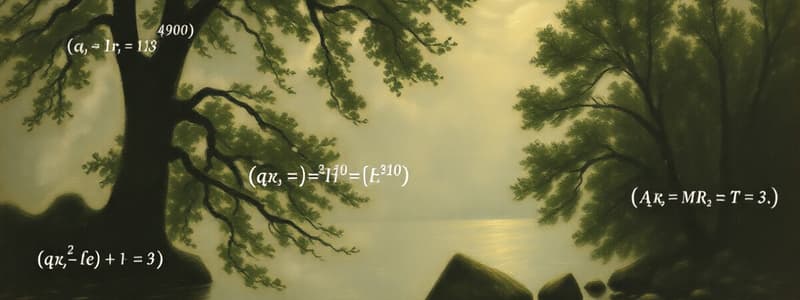Podcast
Questions and Answers
For the quadratic function $f(x) = a(x + 1)(x + 5)$, what are the x-intercepts of the graph?
For the quadratic function $f(x) = a(x + 1)(x + 5)$, what are the x-intercepts of the graph?
- (1, 0) and (5, 0)
- (-1, 0) and (-5, 0) (correct)
- (0, 1) and (0, 5)
- (0, -1) and (0, -5)
The equation $kx^2 + 4kx - 1 = k$ always has two real, distinct roots for any real number k.
The equation $kx^2 + 4kx - 1 = k$ always has two real, distinct roots for any real number k.
False (B)
If the y-intercept of the function $f(x) = a(x + 1)(x + 5)$ is (0, -10), what is the value of a?
If the y-intercept of the function $f(x) = a(x + 1)(x + 5)$ is (0, -10), what is the value of a?
2
The axis of symmetry for the quadratic $f(x) = a(x + 1)(x + 5)$ is $x = $ ______.
The axis of symmetry for the quadratic $f(x) = a(x + 1)(x + 5)$ is $x = $ ______.
Match each part of the quadratic function $f(x) = 16 - x^2$ to its description:
Match each part of the quadratic function $f(x) = 16 - x^2$ to its description:
Given $f(x) = log_k(8x - 2x^2)$, for what value of $k$ does the equation $f(x) = 3$ have exactly one solution?
Given $f(x) = log_k(8x - 2x^2)$, for what value of $k$ does the equation $f(x) = 3$ have exactly one solution?
If the graphs of $f(x) = 16 - x^2$ and $g(x) = (x - 4)^2 + k$ intersect only once, then k = 0.
If the graphs of $f(x) = 16 - x^2$ and $g(x) = (x - 4)^2 + k$ intersect only once, then k = 0.
For the rectangle ABCD, where A and B are on the x-axis and C and D are on the graph of $f(x) = 16 - x^2$, if $OA = a$, what is an expression for the area of rectangle ABCD?
For the rectangle ABCD, where A and B are on the x-axis and C and D are on the graph of $f(x) = 16 - x^2$, if $OA = a$, what is an expression for the area of rectangle ABCD?
Flashcards
Quadratic Function
Quadratic Function
A polynomial function of the form f(x) = ax² + bx + c.
X-Intercepts
X-Intercepts
Points where the graph crosses the x-axis (y=0).
Y-Intercept
Y-Intercept
Point where the graph crosses the y-axis (x=0).
Axis of Symmetry
Axis of Symmetry
Signup and view all the flashcards
Vertex of a Parabola
Vertex of a Parabola
Signup and view all the flashcards
Reflection in Y-Axis
Reflection in Y-Axis
Signup and view all the flashcards
Real Distinct Roots
Real Distinct Roots
Signup and view all the flashcards
Area of Rectangle related to Quadratic
Area of Rectangle related to Quadratic
Signup and view all the flashcards
Study Notes
Question 26
- A quadratic function is given as f(x) = a(x+1)(x+5) for x ∈ R and a ∈ Z.
- The graph of f has x-intercepts at (p, 0) and (q, 0) and a y-intercept at (0, -10).
- p = -1, q = -5.
- a = 2.
- The equation of the axis of symmetry is x = -3.
- The coordinates of the vertex are (-3, -16).
- A transformation is applied to the graph of f, involving a reflection in the y-axis and a translation.
- The new coordinates of the point Q mapped from P(-2, 6) are (2, 6).
Question 27
- The quadratic equation is kx² + 4kx – 10 = 0
- For real and distinct roots, the discriminant must be positive, Δ > 0.
- Possible values for k are k < -5 or k > 2.
- Given k = 3 the roots are in the form q/√3 where p, q ∈ Z
- The roots are 2 ± √2.
Question 28
- f(x) = logk(8x – 2x²), for 0 < x < 4, and k > 0.
- The equation f(x) = 3 has exactly one solution.
- k = 2
Question 29
- f(x) = x² - kx + 5, for x ∈ R
- g(x) = x + 4, for x ∈ R.
- The range of f(x) is given by f(x) ≥ c. where c is the minimum value of the parabola f(x).
- Given that (gof)(x) ≤ 0 for all real values of x, the set of possible values for k is k ≥ 4.
Question 30
- f(x) = 16 – x²
- x-intercepts are (4, 0) and (-4, 0).
- The area of rectangle ABCD is given by 32a – 2a³.
- The value of a that maximizes the area is 4/√3.
Question 31
- f(x) = 2(x - h₁)² + k₁
- g(x) = (x - h₂)² + k₂
- The vertex of f is (m, -m²) and the vertex of g is (-m, -m).
- 0 < m < 1
- The graphs intersect at exactly one point.
- m = 1/√3.
Question 32
- f(x) = p(x - 1)(x-q).
- y-intercept of f(x) is (0, -3)
- Axis of symmetry is x = 2.
- q = 3.
- p = 1.
- Possible values for k are k = 2, or k = -2/3 ± √13/3
Studying That Suits You
Use AI to generate personalized quizzes and flashcards to suit your learning preferences.




